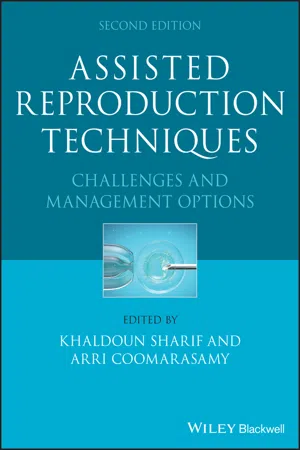
Assisted Reproduction Techniques
Challenges and Management Options
- English
- ePUB (mobile friendly)
- Available on iOS & Android
Assisted Reproduction Techniques
Challenges and Management Options
About this book
Assisted reproduction techniques have led to the birth of 8 million babies worldwide
Assisted reproduction techniques (ART), in particular in-vitro fertilization and intra-cytoplasmic sperm injection, are the most advanced forms of infertility treatment. They involve numerous counseling, medical, surgical and laboratory-based steps. At each step various problems and complications could be encountered that challenge even the most experienced ART practitioners. Moreover, patients with complex medical disorders may require ART, presenting further challenges.
Assisted Reproduction Techniques will stimulate resourceful thinking in the ART practitioner when faced with these challenges. It outlines various management options, the reasoning behind them, and the evidence on which they are based to enable the practitioner to choose the most suitable solution for the needs of each patient.
Written by 171 internationally renowned experts, Assisted Reproduction Techniques follows the patient's journey throughout the whole ART process, with chapters on:
- Counseling and preparation
- Pituitary suppression and ovarian stimulation
- Oocyte retrieval
- Embryo transfer
- The luteal phase
- The ART laboratory
- The male patient
- The ART pregnancy
- General and organizational issues
Each of the 116 concise chapters includes clinical cases, background, evidence-based practical management options, preventive measures, key-point summaries of the important details and answers to questions patients ask.
Assisted Reproduction Techniques first edition has established its place as a "must read" for ART trainees and practitioners alike, and in this second edition all chapters have been updated, with the addition of new ones addressing training issues, organizational and business skills, and social media use in ART.
Frequently asked questions
- Essential is ideal for learners and professionals who enjoy exploring a wide range of subjects. Access the Essential Library with 800,000+ trusted titles and best-sellers across business, personal growth, and the humanities. Includes unlimited reading time and Standard Read Aloud voice.
- Complete: Perfect for advanced learners and researchers needing full, unrestricted access. Unlock 1.4M+ books across hundreds of subjects, including academic and specialized titles. The Complete Plan also includes advanced features like Premium Read Aloud and Research Assistant.
Please note we cannot support devices running on iOS 13 and Android 7 or earlier. Learn more about using the app.
Information
SECTION ONE
Counseling and preparation
1
Risk of cancer from ovarian stimulation
Case History: A 36‐year‐old woman had controlled ovarian stimulation as part of IVF treatment, resulting in a term pregnancy 2 years previously. Following that, her mother developed breast cancer at the age of 61 years. Now the patient desires another pregnancy, but she is concerned about the risk of cancer due to ovarian stimulation. How should she be counseled?
Background
Management options
Breast cancer
Ovarian cancer
Table of contents
- Cover
- Table of Contents
- Title Page
- Copyright Page
- Dedication Page
- Contributors
- Preface to the second edition
- Preface to the first edition
- How to use this book
- Abbreviations
- SECTION ONE: Counseling and preparation
- SECTION TWO: Pituitary suppression and ovarian stimulation phase
- SECTION THREE: Oocyte retrieval
- SECTION FOUR: Embryo transfer
- SECTION FIVES: The luteal phase
- SECTION SIX: The ART laboratory
- SECTION SEVEN: The male patient
- SECTION EIGHT: The ART pregnancy
- SECTION NINE: General and organizational issues
- Index
- End User License Agreement